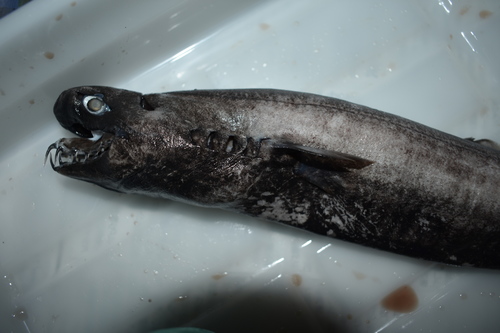
Viper dogfish
The Atlantic bluefin tuna (Thunnus thynnus) is a magnificent and highly migratory species of tuna found in the Atlantic Ocean. Renowned for its size, speed, and commercial value, it plays a crucial role in the marine ecosystem. This species is also know for its unique physiology, including its warm-bloodedness.
Unknown Unknown years
Lifespan
47-54 cm
Length
Least Concern
Conservation Status
Unknown km/h
Swimming speed
Carnivorous
Diet
Local Migration
Migration
Appearance Overview
The Atlantic bluefin tuna is a large, streamlined fish with a metallic blue body and a silvery underside.
Color
Dark metallic blue on top, silvery underside
Body shape
Torpedo-shaped, built for speed and endurance
Fins
Two dorsal fins, the first depressible; small finlets running down the back and belly towards the tail
Length
Up to 13 feet (4 meters), commonly 6.5 feet (2 meters)
Weight
Up to 2,000 lbs (900 kg), commonly around 550 lbs (250 kg)
Diet
Carnivorous, feeding on a variety of fish (such as herring, mackerel, and hake), squid, and crustaceans.
Feeding Behavior
Highly active predator that uses its speed and agility to hunt. They often hunt cooperatively, corralling and herding prey.
Social Behavior
Forms large schools, especially during migration and spawning. Schools can be segregated by size.
Commercial Relevance
Extremely high value, particularly in the sushi and sashimi markets. It is one of the most commercially valuable fish species.
Conservation measures
Subject to strict international fishing quotas and regulations managed by organizations like ICCAT. Marine Protected Areas and gear restrictions are also implemented.
Status
Western Atlantic stock: Endangered; Eastern Atlantic and Mediterranean stock: Near Threatened
Threats
Historical overfishing has severely depleted populations. Bycatch in other fisheries, climate change, and habitat degradation also pose threats.
Habitat Distribution
Depth Range
0-1,000 meters (0-3,280 feet), typically found in the upper layers of the water column.
Geographic Range
Western Atlantic: from Newfoundland to the Gulf of Mexico. Eastern Atlantic: from Norway to the Mediterranean Sea and West Africa.
Preferred Environment
Pelagic, open ocean environments, but they can also be found in coastal waters. They prefer temperate waters.
Reproduction and Life Cycle
Breeding Habits
Spawns in specific areas, with the Gulf of Mexico and the Mediterranean Sea being major spawning grounds. Spawning typically occurs in spring and summer.
Development Stages
Eggs are pelagic (free-floating). Larvae develop rapidly, feeding on plankton and growing quickly. Juveniles form schools and gradually move to adult feeding grounds.
Fecundity
Highly fecund; a large female can release up to 30 million eggs per spawning season.
Maturity Age
Western Atlantic stock: matures around 8-12 years; Eastern Atlantic stock: matures around 4-5 years.
Faqs about Viper dogfish
How long do Atlantic bluefin tuna live?
Atlantic bluefin tuna can live up to 40 years, although the average lifespan is likely shorter due to fishing pressure.
How fast can Atlantic bluefin tuna swim?
They are among the fastest fish in the ocean, capable of reaching speeds of up to 43 mph (70 km/h) in short bursts.
Are Atlantic bluefin tuna warm-blooded?
Atlantic bluefin tuna are warm-blooded, which allows them to maintain a body temperature higher than the surrounding water. This helps them thrive in a wide range of water temperatures.
Do Atlantic bluefin tuna migrate?
Yes, they undertake long migrations across the Atlantic Ocean for feeding and spawning.
What organization manages bluefin tuna fishing?
ICCAT (International Commission for the Conservation of Atlantic Tunas) is the primary organization responsible for managing bluefin tuna populations.
Why are bluefin tuna endangered (Western Atlantic Stock)?
Overfishing has dramatically reduced their numbers. Strict management is crucial to allow populations to recover.
What do bluefin tuna eat?
They primarily eat smaller fish, squid, and crustaceans.
Why is bluefin tuna so expensive?
Bluefin tuna meat is highly prized for its flavor, texture, and high fat content, making it a delicacy in Japanese cuisine.
Copyright @ Nature Style Limited. All Rights Reserved.
 English
English